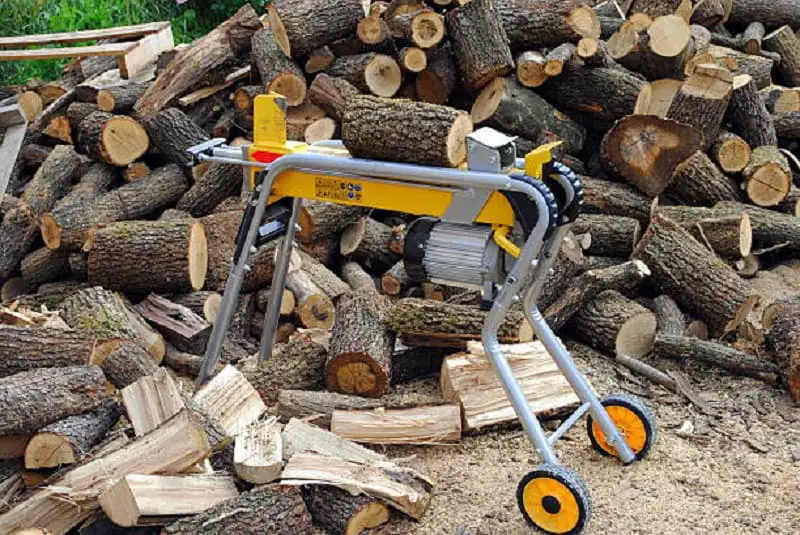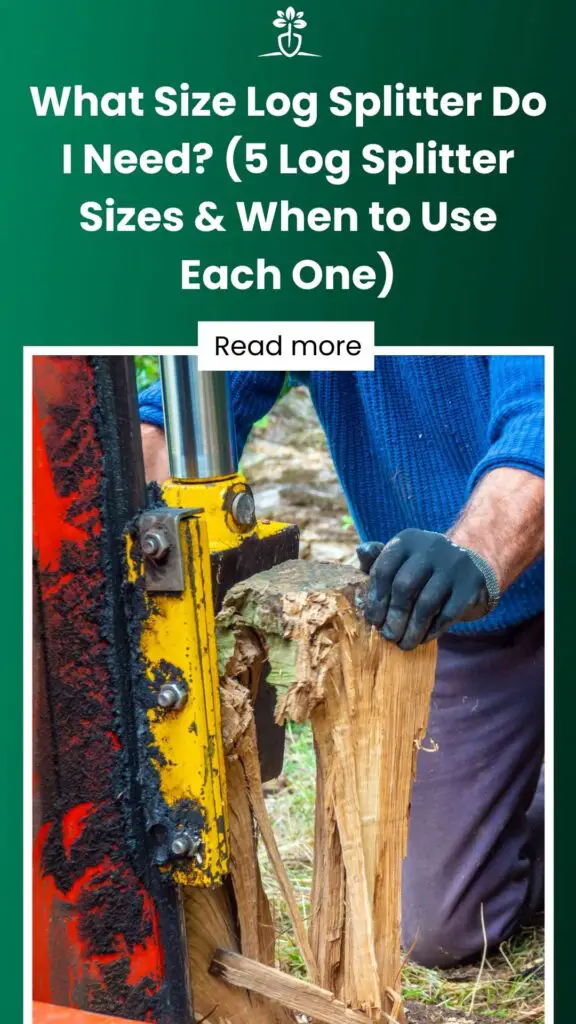What Size Log Splitter Do I Need? (5 Log Splitter Sizes & When to Use Each One)
Have you ever noticed how a friend’s perfectly fitting sneakers just feel all wrong on your feet?
Keeping in mind various factors, we have come up with a comprehensive guide on choosing the perfect log splitter size for you. Read on to find out answers for all your log splitter size questions.
Log splitter size depends on its tonnage. The more the tonnage, the bigger the logs that can easily be hacked by a log splitter. Besides that, the type of wood you need to cut also plays an essential role in what splitter size will work best. You can find log splitters anywhere between 4+ tons to 30+ tons and more.
Contents
Do you even Need a Log Splitter?

Before we talk about how to choose the best log splitter and the varying tonnage varieties available, it is crucial to ask yourself one essential question: Do you need a log splitter?
Better performing log splitters can cost you $1000 on average, and you always have the option of renting one when needed.
However, if you are someone who regularly needs to chop firewood, this machine saves not only your back but also money in the long run.
Wood chopping is a laborious task, and having a log splitter can significantly lessen your workload. Plus, if you are someone who heats wood fuel, it provides you with the flexibility to time your wood splitting sessions when convenient.
You also have to think of the toll manual chopping with an ax takes on your body, especially if you work with knotted, denser woods.
Whether you have your woodlot or wood is delivered to you, there are several log sizes to split. Some logs may be on the smaller side and need no splitting at all, whereas logs with wider diameters need to be split multiple times.
For larger logs, hacking by hand can be extremely time-consuming. With a log splitter, you enjoy the ease of going through bigger wood logs much more efficiently.
We only recommend renting a splitter if you have smaller wooden logs. However, if you are a regular wood burner, that can hardly be the case.
Owning your log splitter eases the workload by helping spread it out over weeks, even months.
Therefore, if you are someone who needs to chop firewood regularly, then buying a log splitter makes sense. It is effective, saves you time, and the buying cost is returned sooner than you can imagine.
Just calculate the rent for a log splitter for one session and determine how much money you will need to spend for all the sessions you will need to hack through the woodpile.
These costs add up fast, and you will eventually agree that for a regular wood splitter, owning a log splitter is the best choice.
How is Log Splitter Size Measured?
There are several varying size log splitters that you can choose from based on your needs. For that, you need to understand how a log splitter size is measured.
The size of any log splitter is based on its tonnage.
Now, what do we mean by the term tonnage? The tonnage is the amount of force that the splitter will exert while splitting wood. Therefore, you need a log splitter with less tonnage when chopping softwoods and a higher tonnage when chopping hardwoods.
Let’s talk about the hardness of the wood. To measure log splitter sizes, the hardness or softness of the wood plays a crucial role. The type of woodpile you have determines the tonnage you need.
Softer woods, like pine, that burn quickly need splitters with less tonnage. Similarly, hardwoods that produce more heat, like hickory and oak, need splitters with more tonnage for clean splits.
Similarly, when choosing the size of a log splitter, go for one suitable for the biggest logs in your pile. The wider the log, the more tonnage it will need.
Another essential factor to consider is whether you will be hacking through seasoned wood or greenwood.
Do not undermine the tonnage difference required to split seasoned and greenwood. Freshly fallen, wetter greenwood at times requires ten times more splitting force or tonnage compared to seasoned wood that has dried out with time.
Determining how much splitting force you will need is crucial, so you do not end up wasting money on a log splitter without need.
Remember that a larger log splitter isn’t always the best option. Mobility, however, is an issue due to heftiness. Thus, if you need to split softwood with smaller diameters, it is good to opt for less tonnage – electric log splitters work great for this.
Bigger log splitters with higher tonnage usually have longer cycles – taking more time to cut through logs than smaller log splitters.
Here is an excellent video that will help you determine log splitters based on tonnage.
Different Log Splitter Sizes
Log splitter sizes are varying units with different tonnage. You base splitter tonnage upon the type of wood and the diameter of the log.
Every wooden log is different based on their hardness, whether they are green or seasoned and diameter. Thus, there cannot be a perfect guideline.
However, a general size guide, based on the diameter and the type of wood (green or seasoned), is as follows:
1. 6 Ton Log Splitter
A 6-ton log splitter is good enough to split a seasoned wood log with a 6-inch diameter. Such a splitter is suitable for residential use when you only need to chop up smaller diameter logs.
You can use such splitters for woods with a hardness between 300 – 900 lbs. Softwoods like alder and catalpa fall in this category.
2. 7 Ton Log Splitter
A 7-ton log splitter can split a 12-inch seasoned wood log. Remember that a greenwood log of the same diameter would require a splitter of much higher tonnage.
If we go by hardness, then a 7-ton log splitter works well with mostly 6-inch diameter softwoods with a hardness of 600 – 900 lbs and some hardwoods up to 1500 lbs of the same width.
3. 16 Ton Log Splitter
To split a greenwood log that is 12-inch in diameter, you need a 16-ton log splitter. Please note that you can split a seasoned wooden log of the same diameter using half the tonnage.
You can use a 16-ton log splitter to hack through wood logs of various hardness, including softwoods and hardwoods of varying diameters.
You can split 6-inch wood logs of hardness between 1500 to 2200 lbs. For 12-inch wood logs, you can work with wood logs with a hardness of 300 to 900 lbs.
4. 20 Ton Log Splitter
A 20-ton log splitter can split seasoned logs with a 24-inch diameter – making it a good choice if you split hardwood logs daily.
If we look at this splitter by wood hardness, it can split 12-inch logs between 900 and 1500 lbs. You can also use it to chop 18-inch logs with a hardness of 300 to 900 lbs.
5. 30+ Ton Log Splitter
A 30+ ton log splitter chops logs with 30 tons of force and is excellent at hacking through larger greenwood logs. It is powerful enough for a 24-inch greenwood log.
It can cut through 18-inch wooden logs with a hardness of 900 – 2200 lbs. As diameter increases, 30+ can usually handle denser wood – efficiently hacking through 24-inch wooden logs anywhere between 300 to 2200 lbs.
Please keep in mind these sizes and their capacities are subjective to different wood types and their conditions.
What Size Log Splitter Should You Use to Split Oak?
Oak is a hardwood with a hardness rating of 1620 lbs. Therefore, you need a log splitter with a higher tonnage to split it efficiently.
Oakwood logs can differ in size; however, oak is a large tree. To split oak logs that are 24 to 36-inch in diameter, you will need a 30+ ton log splitter.
The Ideal Log Splitter Size for You (Summary)
The ideal log splitter for different people will vary. What may be extensive tonnage for one can work for another who needs to split hardwoods regularly. The ideal splitter size is subjective to usage requirements.
As a rule of thumb, opt for smaller size log splitters to split seasoned softwoods with smaller diameters. Electric log splitter provides enough horsepower for such use. The only thing you need to ensure is that you have somewhere convenient to plug it.
If you need to split green hardwood with wider diameters, you should go for a log splitter with a higher tonnage. Usually, gas-powered splitters provide the split force. Another plus for gas-powered splitters is that they do not need a connection to a power supply source. Buy one with wheels so that you can move it along where you want.
With the information mentioned above, you can select the best log size for you. All you have to do is determine what you will use the splitter for and then match it with the information and unit specifics.






